Note
This material is based upon work supported by the National Science Foundation under Award Number IIA-1355406. Any opinions, findings, and conclusions or recommendations expressed in this material are those of the author(s) and do not necessarily reflect the views of the National Science Foundation.
Viewing and enjoying wildlife on your property continues to be a popular form of outdoor recreation. Research conducted in Columbia, Missouri suggests that about 80 percent of over 200 residential homeowners surveyed valued wildlife and 90 percent of the respondents used their property as a place to enjoy nature.
Landscaping that attracts certain species can provide opportunities to enjoy nature and might increase the value of your property, among other benefits. Habitats that provide food, cover, water and space can be developed for songbirds, butterflies and other pollinators, mammals, reptiles, and amphibians allow you to observe nature close to home (Figure 1).
A habitat for wildlife is as an area that provides their basic needs: food, cover or shelter, water, and space. Each habitat component is an important part of a wildlife-friendly yard. For example, providing supplemental foods for birds can create opportunities for closer observation. Building birdhouses provides nesting space to attract bluebirds, wrens, purple martins, chickadees and other species. Additionally, planting and managing for an appropriate mix of food and cover plants in proper locations can benefit wildlife, butterflies and other pollinator species.
Planning ahead is crucial to developing a successful habitat. It is also helpful to understand some ecological concepts that provide the basis for implementing various management activities. This will help you identify specific habitat components that are in short supply for species of interest and address any deficiencies through active management. With proper planning, you can design habitats that suit your interests and preferences. By the same token, you can design a plan and manage habitats in your yard in such a way that prevents certain species that you consider to be a nuisance from becoming abundant.
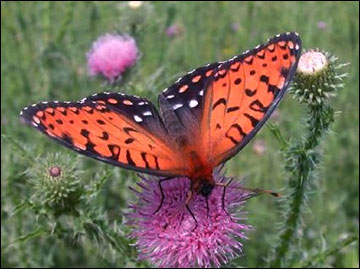 Figure 1
Figure 1
Creating wildlife habitat around your home can attract different species of interest, such as songbirds, small mammals, pollinating insects and many others.
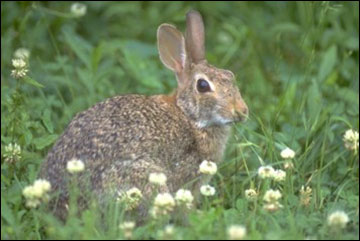

Basic wildlife requirements and ecological concepts
Before developing your plan, you should understand some basic concepts of wildlife management. Make an effort to learn the biology and habitat requirements of species you are interested in attracting. A diversity of habitats and vegetation generally benefits more wildlife species than an area that is primarily made up of one habitat type. Increasing plant diversity, especially with native plants, enhances the potential for attracting a greater number of different wildlife species on your property. Habitat components that provide food, cover, water and space are finite resources, so it is important to identify any limiting factors. Creating a wildlife-friendly landscape in your backyard and surrounding neighborhood is easier with an understanding of basic habitat requirements.
Identify habitat requirements in short supply
Knowing the habitat requirements for species of interest can help you identify areas that can be improved for wildlife around your home. Although many wildlife species benefit from similar types of food and cover, other species might have different habitat needs. Habitat improvement practices can help address limiting factors to improve habitat diversity for species you are interested in attracting.
For example, squirrels require a mixture of trees and shrubs and will not benefit as much from large open areas such as a lawn or open landscape where bluebirds might thrive. However, certain features can benefit many species that seek out similar habitats. Many wildlife species benefit from fruit-producing shrubs, bird feeders and den trees or snags, which they might use for nesting, roosting, perching and feeding. Many species also require a much larger area than you can provide in a limited space, but you can coordinate with neighbors to create larger habitats. Take time to learn about the life history and habitat requirements for species that are of interest to you. Refer to publications in the References section and from the Missouri Department of Conservation for more specific information.
Understand plant succession
Without some sort of disturbance, such as mowing, weeding or pruning, plant communities change over time. This change is referred to as the process of plant succession. The rate of plant succession is determined by climatic factors such as rainfall, temperature and sunlight. For example, herbaceous seed-producing annual plants, such as forbs and legumes, germinate quicker with more sunlight. These annual plants thrive in open conditions but give way to perennial herbaceous plants in a few years. Over time, small trees and shrubs will begin to take over the site. Many of these species are shade-intolerant, meaning they grow best in full sunlight. As time passes, more shade-tolerant plants will dominate the area until, in the final stage of plant succession, a mature hardwood forest takes hold. Although most backyards in residential areas might never go through all of these stages of succession, it is important to understand that areas that are not disturbed will change over time.
Wildlife have adapted to the different stages of plant succession for their food and cover needs. Some species benefit from several stages, whereas others benefit primarily from just one stage of succession. Figure 2 lists a few bird species that are commonly observed in Missouri and the plant successional stage or plant community to which they have adapted.
You can apply management practices to address deficient habitat components and feature the plant community that benefits wildlife species of interest to you. You can also provide more diverse plant communities to attract a greater diversity of wildlife. Early stages of succession are characterized by areas made up of open lawns and grasses, native forbs, gardens and small shrubs. Later stages of succession are characterized by taller shrubs and trees (Figure 3).
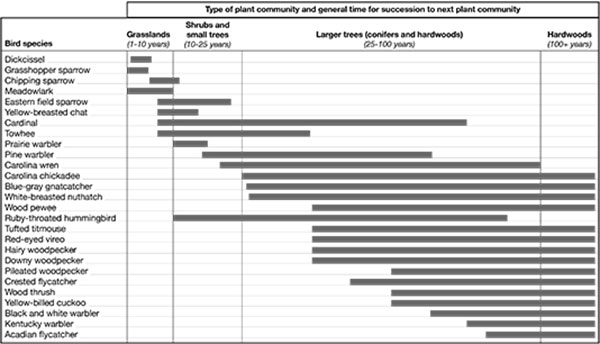
Figure 2
Species of birds commonly observed in Missouri and the type of plant community or habitat type they use for foraging and nesting.
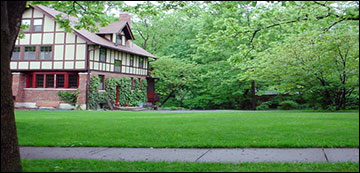 Figure 3
Figure 3
Lawns, gardens and open landscapes are composed of early successional plants. Shrubs and trees are characteristic of later stages of succession.
Improve diversity by creating edges, vertical structure and interspersion
Techniques that increase plant diversity include establishing and managing edge environments, increasing vertical structure and interspersing plant communities throughout your property. As a general rule, a greater number of species are associated with these areas because there is a greater diversity of vegetation that can provide both food and cover in close proximity with one another.
Edge
An edge is created when two or more types of habitat or vegetative stages of succession adjoin each other. For example, an edge exists where your lawn meets an adjacent wooded area. An edge also exists between two different vertical levels of vegetative structure, such as when shrubs are adjacent to low-growing herbaceous vegetation.
You can improve edge habitats in your yard by creating irregularly shaped borders or plantings of different heights adjacent to one another. Edge is increased vertically by stair-stepping vegetation, which means you start with low-growing herbaceous vegetation, then shrubs, small trees and large trees. If your property is surrounded by woodlands, consider planting smaller trees and shrubs at the edge of your yard to create a gradual transition of vegetation from mature trees to your yard. This increased plant diversity can help attract more wildlife (Figure 4).
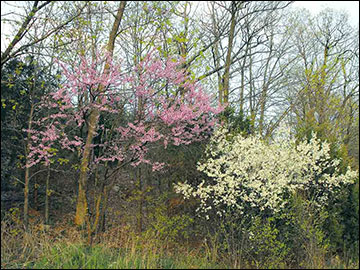 Figure 4
Figure 4
Shrubs, such as red bud and wild plum, can be established adjacent to herbaceous plants and taller trees to provide a transition zone, or edge, made up of diverse plant communities.
Vertical structure
Vertical structure describes the different layers of vegetation extending from the ground up to the tree canopy (Figure 5). These layers of structure provide cover, nesting, roosting and food for a diversity of wildlife. Birds generally tend to forage, nest and spend most of their time in a particular canopy layer. Eastern towhees and brown thrashers feed on the ground and use dense brush found in lower layers of vegetation. Wrens, northern cardinals and northern mockingbirds also forage for food in low-growing shrubs and use the mid-canopy of trees. Red-eyed vireos, scarlet tanagers and many warblers tend to nest and forage in the upper canopy of mature trees. Table 1 shows the general habitat requirements and nesting preferences of several bird species observed in Missouri.
 Figure 5
Figure 5
Birds typically use a specific layer in the tree canopy for foraging and nesting. Increase vertical structure to improve these habitats.
Table 1
General habitat and nesting preferences of commonly observed birds.
| Species | Open landscapes | Shrubs | Few trees | Dense tree canopy | Nest box | Nest platform |
|---|---|---|---|---|---|---|
| American goldfinch | No | Yes | No | No | No | No |
| American robin | Yes | Yes | Yes | Yes | No | Yes |
| Black-capped chickadee | No | No | No | Yes | Yes | No |
| Blue jay | No | Yes | Yes | Yes | No | No |
| Bluebird | Yes | No | No | No | Yes | No |
| Brown thrasher | No | Yes | Yes | No | No | No |
| Catbird | No | Yes | Yes | No | No | No |
| Cedar waxwing | No | No | Yes | No | No | No |
| Chipping sparrow | No | No | Yes | No | No | No |
| Common grackle | No | No | Yes | No | No | No |
| Downy woodpecker | No | No | Yes | Yes | No | No |
| Eastern meadowlark | Yes | No | No | No | No | No |
| Eastern phoebe | No | No | Yes | No | No | Yes |
| Field sparrow | Yes | Yes | No | No | No | No |
| House wren | No | Yes | No | No | Yes | No |
| Indigo bunting | Yes | Yes | No | No | No | No |
| Mourning dove | No | Yes | Yes | No | No | No |
| Northern cardinal | No | Yes | Yes | No | No | No |
| Northern flicker | No | No | Yes | Yes | Yes | No |
| Northern oriole | No | No | Yes | No | No | No |
| Red-eyed vireo | No | No | No | Yes | No | No |
| Red-headed woodpecker | No | No | Yes | Yes | No | No |
| Red-winged blackbird | Yes | No | No | No | No | No |
| Summer tanager | No | No | Yes | Yes | No | No |
| Towhee | No | Yes | No | No | No | No |
| Tree swallow | Yes | No | No | No | Yes | No |
| White-breasted nuthatch | No | No | Yes | Yes | No | No |
| Wood pewee | No | No | No | Yes | No | No |
| Wood thrush | No | No | No | Yes | No | No |
Interspersion
Interspersion refers to how habitats are arranged with one another on a plane, rather than vertically. A mixture of vegetation and successional stages in close proximity to one another or closely arranged in a patchwork pattern is an example of an area with a high degree of interspersion. Creating small islands or patches of vegetation, such as a wildflower garden adjacent to an area of shrubs, can increase interspersion by breaking up large expanses of lawn (Figure 6).
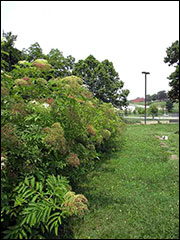 Figure 6
Figure 6
There are many different ways to create interspersed habitats, such as planting shrubs adjacent to open lawn or a flower garden.
Develop a plan
Here are a few tips to help you get started when developing a habitat improvement plan:
- Set your goals and objectives by determining which species you want to attract.
- Learn about the biology and history of wildlife species you are interested in attracting to your home landscape. There are publications and field guides listed in the References section that might be helpful.
- Inventory your landscape to determine what is currently in place and what might be lacking.
- Determine how habitat that attracts wildlife affects your current management activities.
Begin by finding your property boundaries and draw a map or take photos of your house, driveway, fences, outdoor buildings, existing trees, shrubs and flower beds and other important features. Drawing a map or taking photos of your landscape helps document the existing conditions around your home. You can then note any limiting factors that need to be addressed in order to achieve your objectives.
Put it all together by providing habitat
Although each area is different, wildlife habitat can be improved by planting, managing and arranging more wildlife-friendly plants in backyards and neighborhoods. Planting and managing trees, shrubs and herbaceous plants that are beneficial to wildlife is usually the most important thing you can do to improve habitat around your home landscape.
Consider soil type, climate and other growing conditions that are important for selecting and managing vegetation that provides cover for wildlife. Choose plants that are adapted to your area and can withstand the climate through all four seasons. Native species are highly recommended because they are usually better more adapted to the area, tend to be disease-resistant and are preferred by many species of songbirds and other wildlife.
Planting trees, shrubs and vines
Trees and shrubs are examples of an advanced stage of plant succession and provide important habitats for a variety of wildlife. Table 2 lists selected native trees, shrubs and vines to consider when landscaping for wildlife habitat improvement around your home.
Use a diverse selection of vegetation to provide food and cover for birds and other species of interest, and keep in mind their year-round needs. Trees and shrubs can be established to create seasonal food sources as well as protective cover that is used throughout the year (Figure 7) Plants that benefit wildlife most in spring and summer might not be as beneficial in fall and winter, so plant a variety of vegetation that will benefit wildlife in each season.
Certain foods might only be available in a specific season. In spring and summer, many birds and small mammals seek out foods including soft mast — soft fleshy fruits, such as drupes, berries and pomes — invertebrates such as beetles, bugs, worms, snails and flies; and succulent stems and leaves. These foods are relatively high in protein and minerals, which are crucial at this time of year when many species raise young (Figure 8).
Many wildlife species observed in spring and summer might disappear during fall and winter, either from hibernating or migrating to areas that are more hospitable. In fall and winter, resident wildlife species might seek food and cover in different types of habitats as other preferred food sources become available. For example, many species need high-energy foods, such as acorns and nuts produced by oaks and other hardwood trees (Figure 9). In fall and winter, wildlife consume a variety of foods that might be available, such as seeds from forbs, legumes and grasses; twigs, bulbs, invertebrates, and hard mast. Foods high in carbohydrates and fat are crucial, because energy reserves easily become depleted during cold winter months.
Table 2
A selection of native trees and shrubs beneficial to wildlife in Missouri.
| Common name | Scientific name | Deciduous or evergreen | Growth habit | Wildlife benefit | |||
|---|---|---|---|---|---|---|---|
| Spring and summer fruit | Fall and winter fruit | Seeds or nuts | Attracts butterflies | ||||
| Basswood, American | Tilia americana | Deciduous | Tree | No | No | No | Yes |
| Beautyberry, American | Callicarpa americana | Deciduous | Shrub | Yes | No | No | No |
| Black cherry | Prunus serotina | Deciduous | Tree | Yes | No | No | No |
| Black gum | Nyssa sylvatica | Deciduous | Tree | No | Yes | No | Yes |
| Black raspberry | Rubus occidentalis | Deciduous | Bramble | No | No | No | No |
| Blackberry | Rubus spp. | Deciduous | Bramble | Yes | No | No | No |
| Chokecherry | Prunus virginiana | Deciduous | Tree | Yes | No | No | Yes |
| Coralberry | Symphoricarpos orbiculatus | Deciduous | Shrub | No | Yes | No | No |
| Eastern red cedar | Juniperus virginiana | Evergreen | Tree | No | Yes | No | Yes |
| Elderberry | Sambucus canadensis | Deciduous | Shrub | Yes | No | No | Yes |
| Farkleberry | Vaccinium arboreum | Deciduous | Shrub | Yes | No | No | No |
| Flowering dogwood | Cornus florida | Deciduous | Tree | No | Yes | No | No |
| Grape | Vitis spp. | Deciduous | Vine | Yes | Yes | No | Yes |
| Gray dogwood | Cornus racemosa | Deciduous | Tree | Yes | No | No | Yes |
| Hackberry | Celtis occidentalis | Deciduous | Tree | Yes | Yes | No | No |
| Hawthorn | Crataegus spp. | Deciduous | Tree | No | Yes | No | No |
| Hazelnut | Corylus americana | Deciduous | Shrub | No | No | Yes | No |
| Hickory | Carya spp. | Deciduous | Tree | No | Yes | Yes | Yes |
| Holly, American | Ilex opaca | Evergreen | Tree | No | Yes | No | No |
| Holly, deciduous (a.k.a. possumhaw) | Ilex decidua | Evergreen | Tree | No | No | No | No |
| Nannyberry | Viburnum lentago | Deciduous | Shrub | No | No | No | No |
| Oaks | Quercus spp. | Deciduous | Tree | No | Yes | Yes | Yes |
| Pecan | Carya illinoensis | Deciduous | Tree | No | Yes | Yes | No |
| Persimmon | Diospyros virginiana | Deciduous | Tree | No | Yes | Yes | Yes |
| Pine, shortleaf | Pinus echinata | Evergreen | Tree | No | No | Yes | No |
| Plum, American wild | Prunus americana | Deciduous | Tree | Yes | No | No | No |
| Red buckeye | Aesculus glabra | Deciduous | Tree | No | No | Yes | No |
| Red mulberry | Morus rubra | Deciduous | Tree | Yes | No | No | No |
| Sassafras | Sassafras albidum | Deciduous | Tree | Yes | No | No | Yes |
| Serviceberry | Amelanchier arborea | Deciduous | Tree | Yes | No | No | No |
| Spicebush | Lindera benzoin | Deciduous | Shrub | No | Yes | No | Yes |
| Strawberry bush | Euonymus americanus | Deciduous | Shrub | No | Yes | No | No |
| Sumac, aromatic | Rhus aromatica | Deciduous | Shrub | Yes | No | No | Yes |
| Sumac, smooth | Rhus glabra | Deciduous | Shrub | No | Yes | No | Yes |
| Sumac, winged | Rhus copallinum | Deciduous | Shrub | No | Yes | No | Yes |
| Trumpet creeper | Campsis radicans | Deciduous | vine | No | No | Yes | No |
| Viburnums | Viburnum spp. | Deciduous | Shrub | No | Yes | No | Yes |
| Virginia creeper | Parthenocissus quinquefolia | Deciduous | Vine | Yes | Yes | No | Yes |
| Wafer ash | Ptelea trifoliata | Deciduous | Tree | Yes | Yes | No | Yes |
| Wahoo | Euonymus atropurpurea | Deciduous | Tree | No | Yes | No | Yes |
| Witch hazel, American | Hamamelis virginiana | Deciduous | Shrub | No | No | No | Yes |
Note
All of these plants also offer nectar and pollen or serve as host plants for pollinators.
 Figure 7
Figure 7
Thickets of shrubs, such as this elderberry, provide food and cover for a variety of wildlife species, including pollinators.
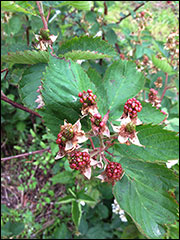 Figure 8
Figure 8
Many plant species produce soft mast, or fruits, which are good food sources for wildlife.
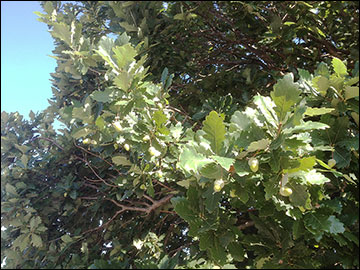 Figure 9
Figure 9
Oaks are one of many hardwood trees that produce hard mast, which are an important food source for many species.
Planting herbaceous vegetation
Besides trees and shrubs, wildlife use a variety of herbaceous plants for food and cover. Most herbaceous species are perennials, but some are annuals or biennials. Annuals complete their life cycle in a year, whereas biennials take two years to flower and produce seed. Perennials live for three or more years without needing replanting.
Lawn grasses and vegetation around homes are mostly composed of ornamental plantings, many of which are introduced flowering species. However, there are many native species that should be considered, and more nurseries are supplying native plants for landscaping. Many flowering herbaceous species can be planted specifically to attract butterflies and other pollinating insects, as well as hummingbirds. Refer to MU Extension publication G9419, Attracting Hummingbirds to Your Property, for more specific information on flowering plants that provide foods for hummingbirds.
When establishing herbaceous plants for food and cover, keep vertical structure in mind. Establish herbaceous plants adjacent to shrubs and intersperse them across your yard to create a diverse landscape that attracts more wildlife. Table 3 provides a list of herbaceous plants that can be established to benefit wildlife, butterflies and pollinating insects.
Table 3
A selection of native herbaceous plants that have benefits for wildlife, such as birds, butterflies and pollinators.
| Common name | Scientific name | Growth habit | Blooming time | Fall or winter seed | ||
|---|---|---|---|---|---|---|
| Spring | Summer | Fall | ||||
| Aster | Aster spp. | Perennial | No | Yes | Yes | Yes |
| Bergamot | Monarda fistulosa | Perennial | Yes | Yes | No | No |
| Black-eyed Susan | Rudbeckia hirta | Biennial | No | Yes | No | Yes |
| Blazing star | Liatris pycnostachya | Perennial | No | Yes | No | Yes |
| Butterfly weed | Asclepias tuberosa | Perennial | No | Yes | No | No |
| Cardinal flower | Lobelia cardinalis | Perennial | No | Yes | Yes | No |
| Columbine | Aquilegia canadensis | Perennial | Yes | Yes | No | No |
| Coneflowers | Echinacea spp. | Perennial | No | Yes | Yes | Yes |
| Goldenrod | Solidago spp. | Perennial | No | Yes | Yes | No |
| Indian paintbrush | Castilleja coccinea | Perennial | Yes | Yes | No | No |
| Jewelweed | Impatiens capensis | Annual | Yes | Yes | No | No |
| Joe-Pye weed | Eupatorium purpureum | Perennial | No | Yes | No | No |
| Lilies | Lilium spp. | Perennial | Yes | Yes | No | No |
| Missouri evening primrose | Oenothera missouriensis | Biennial | Yes | No | Yes | No |
| Ox-eye sunflower | Heliopsis helianthoides | Perennial | No | Yes | Yes | Yes |
| Partridge pea | Chamaecrista fasciculata | Perennial | No | Yes | No | Yes |
| Phlox, sand | Phlox bifida | Perennial | Yes | Yes | No | No |
| Prairie clover | Dalea purpurea | Perennial | No | Yes | Yes | Yes |
| Rose verbena | Glandularia canadensis | Perennial | Yes | Yes | Yes | No |
| Sedges | Carex spp. | Perennial | Yes | Yes | No | Yes |
| Smartweed, pale | Polygonum lapathifolium | Perennial | No | Yes | Yes | Yes |
| Sunflower | Helianthus annuus | Annual | No | Yes | Yes | Yes |
| Swamp milkweed | Asclepias incarnata | Perennial | Yes | Yes | Yes | No |
| Tickseed coreopsis | Coreopsis lanceolata | Perennial | Yes | Yes | Yes | Yes |
| Tickseed sunflower | Bidens spp. | Annual | No | Yes | Yes | Yes |
| Violets | Viola spp. | Perennial | Yes | Yes | No | No |
Supplemental food source: bird feeders
In addition to planting trees and shrubs that provide food and cover, you can place bird feeders around your property to improve wildlife habitats. There are several publications with information on bird feeders and nest boxes listed in the References section.
There are some key points to consider when implementing a bird feeding program. There is no optimal time to begin feeding, but if you begin a feeding program in fall or winter, continue until spring. Wildlife begin to depend on the food provided by a feeder. You can continue your feeding program throughout the year if you want.
You can attract certain bird species by using different feeder designs and food types. A greater variety of seeds will attract a greater diversity of birds. Most birds consume black oil sunflower seeds and white proso millet and can feed from platform and fly-through feeders. Other foods, such as fruits and thistle seeds, attract species such as orioles and goldfinches, respectively. Suet feeders attract woodpeckers. Table 4 lists foods preferred by birds that frequent feeders in Missouri.
Seed cakes are an easy way to provide a variety of foods. There are commercial mixtures available, but you can make your own seed cakes by heating beef suet until it is fluid, then pouring the semi-liquid suet into a cake or bread mold. Then add grain, sunflower seeds and nuts as the mold is filled and allowing the mixture to cool. This mixture can be cut and placed in hardware baskets or pressed into holes drilled into small logs. If suet is not available, a peanut butter-grain mixture will work well.
Feeders should be cleaned periodically with hot, soapy water fortified with a capful of disinfectant (10 percent bleach) and then rinsed well. The underside of a feeder should have small holes drilled in it to facilitate moisture evaporation and reduce mildew unless it has a screened bottom. If squirrels become a problem at your feeders, you can provide them with an alternative food source, such as an unshelled corn cob nailed to a post or tree. There are also squirrel-proof feeders available for purchase, or you can make your own using metal flashing or vinyl siding wrapped around the feeder post to keep squirrels from the feeder.
Keep bird feeders out of reach of predators such as house cats. House cats are proficient predators and can drastically reduce the number of birds and small mammals around your house. Research has shown that house cats kill hundreds of thousands of birds and untold numbers of mammals each year. If you have a cat, consider keeping it inside or putting a bell on its collar. Report feral cats in your area to a local animal shelter for immediate capture and removal.
Table 4
Food preferences of birds that use backyard feeders.
| Bird species | Preferred food |
|---|---|
| Mourning doves | black oil sunflower seeds, white proso millet |
| Woodpeckers, chickadees, titmice, nuthatches | black oil sunflower seeds, cracked nuts, shelled and broken peanuts, breadcrumbs, suet |
| Blue jays | sunflower seeds (all types), peanuts, cracked nuts and corn, suet |
| Mockingbirds, brown thrashers, robins, thrushes, catbirds | cut apples, oranges, raisins and breadcrumbs |
| Cardinals | sunflower seeds (all types), cracked corn, shelled and broken peanuts |
| Eastern towhees | white proso millet, sunflower seeds (all types), cracked corn, and shelled and broken peanuts |
| Evening grosbeak | sunflower seeds (all types), cracked corn, and shelled and broken peanuts |
| Goldfinches | niger thistle, hulled sunflower seeds, black oil sunflower seeds |
| House finch | black oil sunflower seeds, niger thistle |
| Purple finch | sunflower seeds (all types) |
| Sparrows, juncos | white proso millet, black oil sunflower seeds, wheat, breadcrumbs |
Provide nest boxes for cavity nesting birds
Nest boxes can be used to improve wildlife habitat around your home, particularly if your yard lacks mature trees with dens or cavities (Figure 10). Most people associate nest boxes with bluebirds, but they can benefit other wildlife species as well, including mammals such as squirrels, bats and screech owls. There are a variety of cavity-nesting species that will use appropriately sized nest boxes. Nest boxes for birds should be erected in late winter, prior to the arrival of spring migrants. Refer to MU Extension publication G9413, Nest Boxes for Wildlife, for more information on using nest boxes to attract wildlife that require cavities for nesting and protection.
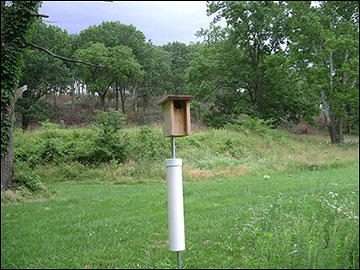 Figure 10
Figure 10
Erecting nest boxes provides valuable habitat for species such as bluebirds that use cavities for nesting.
Maintain snags and den trees
Additional habitat for many species of birds, mammals, reptiles and amphibians can be provided by cavities found in dead, standing trees called snags as well as in live trees that have cavities. Snags and live trees with cavities provide nesting, denning and roosting sites for species such as bluebirds, owls, wrens, flycatchers, wood ducks, nuthatches, chickadees, swallows, titmice, woodpeckers, squirrels, raccoons, bats, black rat snakes and garter snakes. Snags also serve as perching sites for many raptor species as well as feeding sites for brown creepers, nuthatches, kingbirds, woodpeckers, gnatcatchers, lizards, skinks and tree frogs.
Provide a water source
Water is an essential component of any wildlife habitat. You can provide make water available in a variety of ways, from a simple birdbath to a small pond created with wildlife in mind (Figure 11). Raccoons forage for crawdads in shallow pools and creeks; herons and kingfishers feed on small fish; and frogs, dragonflies, birds and bats prey on flying insects often found above a small pond. For species such as amphibians, water is necessary for reproduction, providing a place to lay eggs and for tadpoles to develop. A pond ecosystem provides a habitat for an array of wildlife that would not otherwise be there and improves conditions for many terrestrial species.
Whether you have a birdbath or a small pond, it is best if a water source is adjacent to protective cover such as shrubs and trees. Keep birdbaths at least three feet above ground level for protection from cats, and place them adjacent to trees and shrubs or herbaceous vegetation that provides cover and offers perching opportunities for birds. The water should be shallow, especially around the edges, to afford access to birds both large and small.
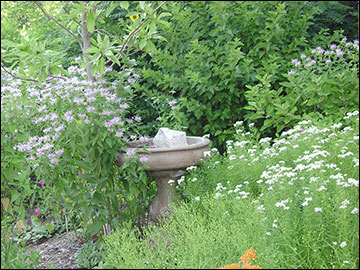 Figure 11
Figure 11
A water source, such as a small birdbath, adjacent to a bird feeder and vegetative cover provides a valuable habitat component for birds.
Mammal habitats around your home
There are a variety of mammals that commonly use habitats found in residential and urban areas. Species such as white-tailed deer, raccoons, groundhogs, cottontail rabbits, bats and many others can be observed around your home or neighborhood and benefit from available habitat. Table 5 lists general habitat preferences of some mammals commonly found around residential areas.
Certain management techniques can be implemented to increase habitat for many of these species. For example, an increasing number of people are interested in attracting bats to their backyard. Bats are nocturnal flying mammals that consume a large volume of insects. If you want to increase the bat population around your home, refer to MU Extension publication G9460, Bats of Missouri: Information for Homeowners. That publication also includes plans for constructing a bat box and recommendations for where to place them in your yard. It is also important to plant vegetation and increase the plant diversity in your home landscape that provides habitat for night-flying insects.
Table 5
Food and cover preferences of selected mammals that might use habitats in residential areas.
| Mammal | Type of habitat | Foods | ||||||||
|---|---|---|---|---|---|---|---|---|---|---|
| Species | Grasses, open landscapes | Shrubs, trees | Tunnels or burrows | Structures | Herbaceous vegetation | Soft mast and fruits | Seeds or hard mast | Insects | Worms | Small animals, carrion |
| Raccoons | Yes | Yes | No | No | Yes | Yes | No | Yes | No | Yes |
| Cottontail rabbits | Yes | Yes | No | No | Yes | No | No | No | No | No |
| Groundhogs | Yes | Yes | Yes | No | Yes | Yes | No | No | No | No |
| Fox squirrels | No | Yes | No | Yes | Yes | No | Yes | No | No | No |
| Gray squirrels | No | Yes | No | Yes | Yes | No | Yes | No | No | No |
| Big brown bats | No | Yes | No | Yes | No | No | No | Yes | No | No |
| Little brown bats | No | Yes | No | Yes | No | No | No | Yes | No | No |
| White-tailed deer | Yes | Yes | No | No | Yes | Yes | Yes | No | No | No |
| Moles | Yes | No | Yes | No | No | No | No | Yes | Yes | No |
| Prairie voles | Yes | No | Yes | No | Yes | No | Yes | No | No | No |
| Oppossums | No | Yes | No | No | No | Yes | No | Yes | No | Yes |
| Skunks | No | Yes | No | Yes | No | No | No | Yes | No | Yes |
| Coyotes | Yes | Yes | No | No | No | Yes | No | Yes | No | Yes |
Implement and evaluate your plan
Implementing a management plan that benefits wildlife requires an investment of time and money. It is not necessary to complete the project all at once or in a single year, so you should work according to your schedule and budget. Think of each management practice as part of your overall plan. Some practices, such as establishing trees and shrubs, might take several years to provide food and cover for wildlife. Other practices, such as setting out a bird feeder or erecting nest boxes, can have more of an immediate effect. However, it is important to provide some food, water and cover as soon as possible so you begin to see positive results.
Take pictures of your yard and document birds and other wildlife species you observe using habitats you have created. Use this information to evaluate improvements you have made and locations that can be used to modify your plan. Most importantly, promote a diversity of habitats, be creative, be patient and have fun implementing your plan.
Improving habitats in neighborhoods
The type of habitat in your surrounding neighborhood also influences what species you are able to attract to your yard. Many of the ideas discussed in previous sections can also be used to improve wildlife habitats in your neighborhood. Your property might lack a habitat component that your neighbor's property has in abundance, so it would be beneficial to coordinate your management efforts. Work together with your neighbors to outline common habitat management objectives. Improving the quality of habitat across a larger space within the neighborhood makes these areas attractive to a broader variety of wildlife species.
Suburban and urban land development also have a significant effect on the quality of these areas for wildlife. Here are a few recommendations for maintaining and improving these areas for wildlife:
- Avoid planting shrubbery and small trees to attract wildlife in medians and adjacent to roadsides, as this will increase the chances of collisions.
- If you are considering a planting, establish patches of herbaceous flowering vegetation to attract pollinators and monarchs in these areas.
- Protect woodlands and forests adjacent to streams for approximately 100 feet on each side of these areas. Riparian vegetation provides excellent habitat for wildlife and bird species.
- Leave shrubs, trees and native herbaceous vegetation in place when building or developing new areas.
- Concentrate homes within a subdivision such that larger areas of undeveloped vegetation are maintained for wildlife benefits.
- Connect remnant patches of habitat within the neighborhood. These corridors provide important areas for food and protective cover for wildlife throughout the year.
- Avoid planting extensive areas of exotic grasses such as tall fescue in lawns. These grasses have little food value and require significant mowing and fertilization.
- Use native vegetation where possible in your home landscape and when replanting common areas in your neighborhood.
- Avoid planting invasive species, as they will have some negative effects on the surrounding landscape. It is important to include a diversity of vegetation in your home landscape in each season. Autumn olive, purple loosestrife bush and Japanese honeysuckle are just a few examples of species that can provide a food source for wildlife, but they do so at the expense of native plant diversity and negatively affect wildlife over time. Many native species serve well to attract wildlife, so there is no need to establish introduced plants that will invade into surrounding areas.
- Reduce pesticide and fertilizer use and follow all label directions during application of lawn-care products. Many species of wildlife rely on insects, either directly or indirectly, for survival. Most insecticides do not target a single species but rather control a broad range of insects, including many that are beneficial.
References
- Fishel, E., C. Nilon and R.A. Pierce II. 2016. Breeding bird and plant associations with urban residential land management practices in Columbia, Missouri. 76th Midwest Fish and Wildlife Conference. January, 2016. Grand Rapids, MI.
- Landscaping for backyard wildlife. Missouri Department of Conservation. Publication E454.
- Landscaping and gardening for birds. 2012. Oklahoma State University Extension Publication F-6435. 12pp.
- Native landscaping for wildlife and people: how to use native Midwestern plants to beautify your property and benefit wildlife. 2002. Missouri Department of Conservation. 181 pp.
- Tallamy, D. 2007 Bringing nature home. How you can sustain wildlife with native plants. 358 p.
- Butterfly gardening and conservation. 2005. Missouri Department of Conservation. Publication E00471.
- Native plants for your landscape. Missouri Department of Conservation (PDF).
- Missouri Grow Native Program.
- Missouri Department of Conservation Plant and Wildlife field guides.
Photo credits
Missouri Department of Conservation, Sue Bartelette, Sarah Denkler, Nadia Navarrete-Tindall, Robert Pierce